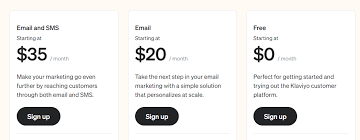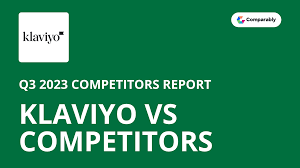Klaviyo Pricing: A Comprehensive Guide for Businesses
May 15, 2024
Ron

Klaviyo, a leading email marketing automation platform specifically designed for e-commerce, has risen in popularity thanks to its robust feature set that enables businesses to create personalized, data-driven campaigns. But as with any tool, the primary concern for most businesses is the cost. In this in-depth guide, we’ll dive into Klaviyo’s pricing structure, helping you determine if it’s the right fit for your business.
Klaviyo’s Pricing Overview
At its core, Klaviyo’s pricing model is based on the number of contacts you have in your list. As your list more contacts grows, so does the price you pay. But rather than having fixed-tier pricing, Klaviyo opts for a more granular approach, adjusting costs based on specific contact count ranges.
The Free Plan
For businesses just starting or those wanting to test the waters, Klaviyo offers a free tier. This plan includes:
- Up to 250 contacts
- Up to 500 email sends
- Access to Klaviyo’s core features, including segmentation and reporting
It’s a great way for businesses to become familiar with the platform without any financial commitment.
Paid Plans
As your contact list exceeds 250, you’ll move into Klaviyo’s paid plans. The cost per paid plan increases progressively based on the number of contacts:
- 251-500 contacts: Approximately $20/month
- 501-1,000 contacts: Approximately $30/month
- 1,001-2,500 contacts: Approximately $60/month
… and so on.
Keep in mind that these are approximate prices, and Klaviyo’s official website should be consulted for the most accurate, up-to-date pricing.
SMS and Additional Features
While email marketing is at Klaviyo’s core, it’s not the only feature on offer. Klaviyo has integrated SMS marketing into its platform, which comes with its own separate pricing:
- Starter: $5/month – for businesses just starting with SMS marketing
- Growth: Based on the number of SMS messages sent, typically starting at around $10/month
- Pro: Custom pricing for businesses with extensive SMS marketing needs
Bundled Pricing
For businesses looking to utilize both email and SMS marketing, the company Klaviyo offers bundled pricing options, often providing a discount compared to purchasing both services separately.
Additional Costs to Consider
Beyond the base pricing, there are other factors that might affect the total cost:
- Implementation: If you’re transitioning from another platform or require a customized setup, there might be implementation fees.
- Training: While Klaviyo is user-friendly, larger teams or those unfamiliar with email marketing platforms might benefit from official training sessions, which could come at an additional cost.
- Third-party Integrations: Klaviyo integrates seamlessly with a multitude of e-commerce platforms and tools, but some might come with their own associated costs.
Price vs. Value
When considering Klaviyo’s pricing, it’s crucial to weigh the cost against the value you receive:
- Segmentation: Klaviyo’s ability to segment audiences based on purchasing behavior, engagement, location, and more is unparalleled.
- Automation: With features like abandoned cart emails, welcome sequences, and post-purchase follow-ups, businesses can create automated flows that significantly boost revenue.
- Analytics: Klaviyo’s reporting tools give businesses insights into campaign performance, customer lifetime value, and other crucial metrics, allowing for data-driven decisions.
Klaviyo vs. Competitors

While Klaviyo offers a host of features tailored for e-commerce, it’s essential to compare its pricing and offerings with competitors:
- Platforms like Mailchimp or SendinBlue might offer lower prices for specific contact ranges but might lack some of the e-commerce-centric features Klaviyo provides.
- Enterprise solutions like Salesforce Marketing Cloud or Adobe Campaign might have a broader feature set but come at a significantly higher price point and might be overkill for small to medium-sized businesses.
Is Klaviyo Right for Your Business?
To determine if Klaviyo’s pricing and features align with your needs, consider:
- Business Size and Growth: If you’re rapidly growing, factor in future costs as your contact list expands.
- E-commerce Centricity: Businesses heavily focused on e-commerce might find more value in Klaviyo’s tailored features than a generic email marketing platform.
- SMS Marketing Needs: If SMS marketing is or will be a significant channel for you, Klaviyo’s integrated approach might provide both cost savings and streamlined marketing operations.
SMS Messages
At a basic level, an SMS message is a text message transmitted over cellular networks.
Here are some facts and features:
1. Length: Standard SMS messages have a maximum length of 160 characters. If a message exceeds this limit, it’s split into multiple messages.
2. Universality: SMS doesn’t require internet connectivity, making it accessible even on basic phones and in areas with poor data connectivity.
3. Read Rates: SMS messages have an incredibly high read rate, with most texts being read within a few minutes of reception.
Types of SMS Messages
1. P2P (Person-to-Person): These are the most common SMS messages, exchanged between two individuals.
2. A2P (Application-to-Person): These are automated messages sent from applications to individuals. Examples include bank alerts, appointment reminders, and verification codes.
3. Promotional SMS: These are marketing messages, often bulk-sent to many recipients at once, promoting products, offers, or events.
4. Transactional SMS: Sent post specific transactions, like purchase confirmations or booking acknowledgments.
Business Utility of SMS Messages
1. Customer Service: Businesses use SMS for quick communications like appointment reminders, service updates, and feedback solicitations.
2. Marketing: Promotions, offers, and product launches are often communicated via SMS due to their high visibility.
3. Alerts and Notifications: From flight delays to credit card transactions, businesses use SMS to keep customers informed in real-time.
4. Authentication: SMS messages play a crucial role in two-factor authentication processes, ensuring the security of online accounts.
Benefits of SMS Messaging for Businesses
1. High Open Rates: SMS messages boast an open rate of around 98%, ensuring the message reaches almost every intended recipient.
2. Instant Delivery: SMS messages are delivered in real-time, making them ideal for time-sensitive communications.
3. Broad Reach: Given that even basic phones support SMS, businesses can reach a wide demographic, including those without smartphones.
4. Cost-Effective: Sending bulk SMS messages is often cheaper than other marketing channels, offering a good ROI.
Email Marketing
Email marketing is a powerful digital marketing strategy where emails are sent to a list of your email subscribers, or potential customers. It’s a direct way of communicating offers, news, or updates, and it can be a valuable tool for nurturing leads, increasing sales, and building brand loyalty.
Advantages of Email Marketing
- Cost-Effective: Unlike many other marketing strategies, email marketing can be relatively inexpensive.
- Targeted: You can segment your email list based on different criteria, ensuring that your messages are relevant to the recipients.
- Measurable: With the right tools, you can measure open rates, click-through rates, conversion rates, and more.
- Immediate: Emails can be sent and received within seconds, allowing for timely promotions or news.
- Personal: Emails can be personalized to address the recipient by name or provide tailored recommendations.
Essential Tips for Effective Email Marketing
- Segment Your List: Not everyone on your list will be interested in every email. Segment your list to ensure your message reaches the most relevant audience.
- Craft Compelling Subject Lines: The subject line is often the deciding factor in whether an email is opened.
- Mobile Optimization: Ensure that your emails look and perform well on mobile devices.
- Maintain a Clean List: Regularly remove inactive subscribers or those who have not engaged with your emails in a long time.
- Test and Analyze: A/B test different subject lines, content, and sending times to determine what works best.
- Avoid Spam Traps: Ensure you are compliant with email laws like the CAN-SPAM Act, GDPR, etc. Only send emails to those who have explicitly given permission.
Types of Email Marketing Campaigns
- Newsletters: Regularly scheduled emails that keep your audience informed about news, updates, or content.
- Promotional Emails: Emails about offers, sales, or discounts.
- Welcome Emails: Sent to new subscribers or customers, often including a thank-you note and perhaps a special offer.
- Transactional Emails: Triggered by specific actions like making a purchase, signing up for a webinar, etc.
- Re-engagement Emails: Targeted at inactive subscribers to bring them back into the fold.
Klaviyo Pricing: Popular Email Marketing Tools
There are several email marketing platforms available that offer full email support and a variety of features:
- Mailchimp: A user-friendly platform that’s especially good for small to medium-sized businesses.
- ConvertKit: Known for its robust automation and tagging system.
- AWeber: Offers a wide range of tools and templates.
- SendinBlue: Provides both email and SMS marketing solutions.
- Constant Contact: Offers a variety of email templates and a user-friendly interface.
- GetResponse: Combines email marketing with landing pages and webinars.
Account Page
An “account page” generally refers to a section on a website where users can manage their personal or account-related information. It’s a central hub for users to control preferences, view transaction history, update details, and more.
Common Features of an Account Page:
- Profile Information: Displays basic personal details like name, email, and contact number. It often allows users to update this information.
- Change Password: Option to update or reset the password for security purposes.
- Order History: For e-commerce websites, users can view their past orders, track current ones, and check the delivery status.
- Payment Methods: Allows users to manage and save multiple payment options like credit/debit cards, PayPal accounts, etc.
- Address Book: For sites that require shipping, users can save and edit multiple addresses.
- Subscription Management: If the site offers subscription services, users can manage them here – upgrade, downgrade, or cancel.
- Notifications: Allows users to set preferences for receiving notifications, newsletters, or promotional emails.
- Wishlist or Saved Items: For e-commerce or content-heavy sites, users can save items or articles they’re interested in for later access.
- Security Settings: Options to enable two-factor authentication, see active sessions, or review account activity.
- Account Deletion: A way for users to delete their accounts, often with safety precautions to avoid accidental deletions.
Customer Data
Customer data pertains to information collected about individuals who interact with a business. This data can offer insights into the preferences, behaviors, and demographics of customers, thereby enabling businesses to tailor their products, services, and marketing efforts more effectively. However, managing customer data also comes with significant ethical and legal responsibilities.
email and chat support
Email and chat support are two primary customer service channels in the digital realm. Both play crucial roles in providing timely and effective support to customers, yet each has its own unique set of advantages, challenges, and best practices.
Email Support
Advantages:
- Documentation: Both customers and support agents have a record of communication.
- Flexibility: Agents can take the time to research and provide thorough answers.
- Scalability: It’s easier to handle a large volume of queries, as they can be addressed sequentially.
Challenges:
- Delay in Response: It may take longer for customers to get answers compared to real-time chat.
- Potential Misunderstandings: Without real-time back-and-forth, there might be more room for miscommunication.
- Thread Management: Long email threads can become confusing.
Conclusion
Klaviyo’s pricing is transparent and scales with your business’s growth. Its focus on e-commerce and the integration of both email and SMS marketing makes it a compelling choice for many online retailers. However, as with any investment, it’s crucial to weigh the costs against the potential ROI and consider both your current needs and future growth. Armed with the information in this guide, you’re now better equipped to make an informed decision about using Klaviyo for your own ecommerce email marketing needs.
What it’s Like to work with Underground Ecom?

$1.9M
EMAIL MARKETING REVENUE
287%
Increase in
Revenue

37% OF REVENUE THROUGH EMAIL MARKETING

$1.9M
EMAIL MARKETING REVENUE
287%
Increase in
Revenue

37% OF REVENUE THROUGH EMAIL MARKETING